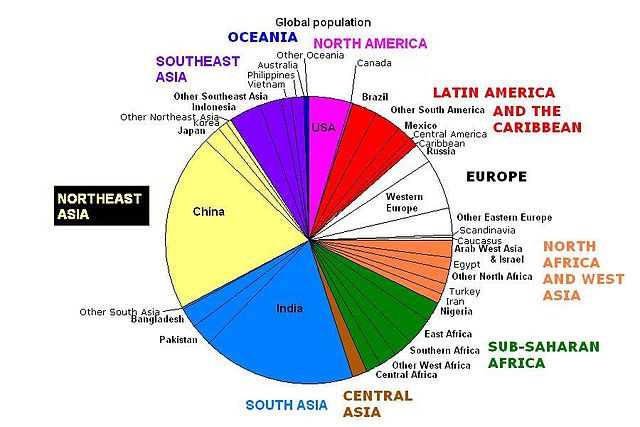 |
This is a file from the Wikimedia Commons. Information from its description page there is shown below.
Commons is a freely licensed media file repository. You can help.
|
 |
This image was uploaded in the JPEG format even though it consists of non-photographic data. This information could be stored more efficiently or accurately in the PNG format or SVG format. If possible, please upload a PNG or SVG version of this image without compression artifacts, derived from a non-JPEG source (or with existing artifacts removed). After doing so, please tag the JPEG version with {{ Superseded|NewImage.ext}}, and remove this tag. This tag should not be applied to photographs or scans. For more information, see {{ BadJPEG}}. |
|
|
Summary
| Description |
Global population distribution by region. Colours indicate broad regions while smaller divisions within these colours indicate subregions. "Other North America" refers to Greenland and St. Pierre & Miquelon. The division between Western and Eastern Europe follows the old Iron Curtain line, except that Greece is delegated to Eastern Europe. Iceland and Finland are included in Scandinavia. Arab West Asia includes Cyprus. Mauritania and Sudan are included in North Africa while Niger is included in West Africa and Chad is included as Central Africa. Rwanda & Burundi are included as East Africa. Southern Africa is Angola, Zambia, and Mozambique south. Central Asia includes Afghanistan, Nepal, Bhutan and Mongolia. |
| Date |
March 2008 |
| Source |
self-made; data collected from Wikipedia, graph made with Excel, details added with Paint |
| Author |
Brutannica |
Licensing
| Public domainPublic domainfalsefalse |
 |
I, the copyright holder of this work, release this work into the public domain. This applies worldwide.
In some countries this may not be legally possible; if so:
I grant anyone the right to use this work for any purpose, without any conditions, unless such conditions are required by law.Public domainPublic domainfalsefalse
|
| Annotations |
This image is annotated: View the annotations at Commons |
|
|
This selection has made Wikipedia available to all children. Our 500 Children's Villages provide a home for thousands of vulnerable children. Beyond our Villages, we support communities, helping local people establish better schools and delivering effective medical care to vulnerable children. Sponsoring a child is the coolest way to help.



